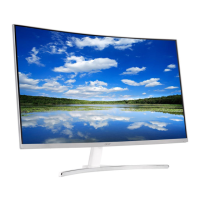
Do you have a question about the Acer ED322Q and is the answer not in the manual?
| Cable lock slot | No |
|---|---|
| Tilt angle range | -5 - 10 ° |
| Panel type | VA |
| Display diagonal | 31.5 \ |
| Display technology | LED |
| Native aspect ratio | 16:9 |
| Contrast ratio (dynamic) | 100000000:1 |
| Contrast ratio (typical) | 3000:1 |
| Display number of colors | 16.78 million colors |
| Display brightness (typical) | 250 cd/m² |
| Supported graphics resolutions | 1920 x 1080 (HD 1080) |
| Product color | Silver, White |
| Market positioning | - |
| Energy efficiency scale | A to G |
| Depth (with stand) | 207.2 mm |
|---|---|
| Height (with stand) | 526 mm |
| Depth (without stand) | 79.5 mm |
| Width (without stand) | 711.3 mm |
| Height (without stand) | 414.9 mm |
| Weight (without stand) | - g |
Read instructions carefully and follow all warnings marked on the product.
Guidelines for cleaning the monitor, including unplugging it first.
Guidelines for connecting and disconnecting power to the monitor safely.
Guidelines for extension cords, overloading outlets, and using the correct grounded power cord.
Keep small parts out of reach of small children.
Acer's commitment to environmental protection and recycling of used equipment.
Product shipped with power management enabled; activate sleep mode.
Addresses eyestrain, headaches, and physical injury from prolonged computer use.
Tips for adjusting viewing angle, using a footrest, and maintaining posture.
Suggestions to reduce eyestrain, like resting eyes and blinking.
Advice on keeping the display clean, adjusting head level, brightness, contrast, and reducing glare.
Methods to eliminate glare and reflections, like using blinds or a visor.
Details pin assignments for 15-pin and 19-pin display signal cables.
How to turn the monitor ON or OFF.
Explains how to use the shortcut menu buttons for navigation and selection.
How to adjust contrast, brightness, color temperature, and auto adjust.
How to adjust H.Position, V.Position, Clock, and Phase for VGA input.
How to set language, OSD position, timer, and transparency.
How to set Mode, Signal Source, Aspect Ratio, DCR, Over Drive, and Blue Light Filter.
How to reset settings to the factory defaults.
Troubleshooting steps for common issues in VGA mode, like no picture or unstable picture.
Troubleshooting steps for common issues in DVI mode, like no picture.
Troubleshooting steps for common issues in HDMI mode, like no picture.